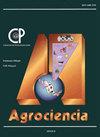墨西哥仙人掌象鼻虫(Metamasius spinolae Gyllenhal)的新寄主
IF 0.5
4区 农林科学
Q4 AGRICULTURE, MULTIDISCIPLINARY
引用次数: 0
摘要
仙人掌象鼻虫(Metamasius spinolae)是仙人掌的害虫。它不仅可以发生在仙人掌属植物中,也可以发生在其他仙人掌和天门冬科植物中。2017年,报告了两种仙人掌(austro圆柱形仙人掌和Peniocereus serpentinus)中存在与仙人掌象鼻虫特征相似的成虫。为了鉴定这种昆虫并确定这两种仙人掌是否是宿主,研究人员于2017年至2019年在墨西哥州的阿克萨普斯科市进行了实地和实验室研究。在4个研究地点选择幼虫受损的茎秆,这些茎秆一直保持在田间条件下,直到成虫出现。记录了刺毛虫在寄主植物上的行为、交配地点、潜伏期和危害发展情况。鉴定出棘棘棘螨,并确定其在亚种和蛇形棘上完成生活史。幼虫以茎的内部部分(髓)为食,造成最大的损害,导致受影响部分的组织腐烂和死亡。成虫以嫩芽和成熟茎为食,造成植株变形和衰弱。这两种仙人掌被证明是寄主植物,可以容纳刺叶分枝杆菌的种群,因此,它们很有可能成为害虫的宿主,然后它们可以迁移到刺梨仙人掌作物上。这篇报道扩展了对仙人掌象鼻虫宿主的认识。所获得的信息应有助于蔬菜种植者在替代寄主、防治水库和避免害虫再次侵染方面采取植物检疫措施。本文章由计算机程序翻译,如有差异,请以英文原文为准。
Peniocereus serpentinus AND Austrocylindropuntia subulata, NEW HOSTS OF THE CACTUS WEEVIL (Metamasius spinolae Gyllenhal) IN THE STATE OF MEXICO
The cactus weevil (Metamasius spinolae) is a pest of Opuntia ficus-indica. It can develop not only in Opuntia species but also in other cacti and members of the Asparagaceae family. In 2017, damage and presence of adult insects with characteristics similar to the cactus weevil were reported in two species of cacti, Austrocylindropuntia subulata and Peniocereus serpentinus. The objective was to identify the insect and determine if the two cacti species are hosts, field and laboratory research was conducted from 2017 to 2019 in the municipality of Axapusco, State of Mexico. Stems with larval damage were selected at four study sites, whic remained in field conditions until the emergence of adult insects. The behaviour of M. spinolae on the host plant, mating sites, incubation period and damage development over time were recorded. M. spinolae was identified and determined to fulfill its life cycle on A. subulata and P. serpentinus. Larvae cause the most damage by feeding on the internal part (pith) of the stems, which causes tissue rotting and death of the affected part. The adult feeds on tender buds and mature stems, causing deformation and weakening of the plant. The two cacti species proved to be host plants that can harbour populations of M. spinolae and, therefore, have a high potential to act as reservoirs of the pest, which can then migrate to prickly-pear cactus crop. This report expands the knowledge of hosts of the cactus weevil. The information obtained shall be useful for vegetable growers to apply phytosanitary measures in alternate hosts, combat reservoirs and avoid re-infestations of the pest.
求助全文
通过发布文献求助,成功后即可免费获取论文全文。
去求助
来源期刊

Agrociencia
农林科学-农业综合
CiteScore
0.50
自引率
33.30%
发文量
51
审稿时长
18-36 weeks
期刊介绍:
AGROCIENCIA is a scientific journal created and sponsored by the Colegio de Postgraduados. Its main objective is the publication and diffusion of agricultural, animal and forestry sciences research results from mexican and foreign scientists. All contributions are peer reviewed. Starting in the year 2000, AGROCIENCIA became a bimonthly and fully bilingual journal (Spanish and English versions in the same issue). Since 2007 appears every month and a half (eight issues per year). In addition to the printed issues, the full content is available in electronic format.
 求助内容:
求助内容: 应助结果提醒方式:
应助结果提醒方式:


